Characteristic Reactions of Mercury Ions (Hg²⁺ and Hg₂²⁺)
- Page ID
- 97274
\( \newcommand{\vecs}[1]{\overset { \scriptstyle \rightharpoonup} {\mathbf{#1}} } \)
\( \newcommand{\vecd}[1]{\overset{-\!-\!\rightharpoonup}{\vphantom{a}\smash {#1}}} \)
\( \newcommand{\id}{\mathrm{id}}\) \( \newcommand{\Span}{\mathrm{span}}\)
( \newcommand{\kernel}{\mathrm{null}\,}\) \( \newcommand{\range}{\mathrm{range}\,}\)
\( \newcommand{\RealPart}{\mathrm{Re}}\) \( \newcommand{\ImaginaryPart}{\mathrm{Im}}\)
\( \newcommand{\Argument}{\mathrm{Arg}}\) \( \newcommand{\norm}[1]{\| #1 \|}\)
\( \newcommand{\inner}[2]{\langle #1, #2 \rangle}\)
\( \newcommand{\Span}{\mathrm{span}}\)
\( \newcommand{\id}{\mathrm{id}}\)
\( \newcommand{\Span}{\mathrm{span}}\)
\( \newcommand{\kernel}{\mathrm{null}\,}\)
\( \newcommand{\range}{\mathrm{range}\,}\)
\( \newcommand{\RealPart}{\mathrm{Re}}\)
\( \newcommand{\ImaginaryPart}{\mathrm{Im}}\)
\( \newcommand{\Argument}{\mathrm{Arg}}\)
\( \newcommand{\norm}[1]{\| #1 \|}\)
\( \newcommand{\inner}[2]{\langle #1, #2 \rangle}\)
\( \newcommand{\Span}{\mathrm{span}}\) \( \newcommand{\AA}{\unicode[.8,0]{x212B}}\)
\( \newcommand{\vectorA}[1]{\vec{#1}} % arrow\)
\( \newcommand{\vectorAt}[1]{\vec{\text{#1}}} % arrow\)
\( \newcommand{\vectorB}[1]{\overset { \scriptstyle \rightharpoonup} {\mathbf{#1}} } \)
\( \newcommand{\vectorC}[1]{\textbf{#1}} \)
\( \newcommand{\vectorD}[1]{\overrightarrow{#1}} \)
\( \newcommand{\vectorDt}[1]{\overrightarrow{\text{#1}}} \)
\( \newcommand{\vectE}[1]{\overset{-\!-\!\rightharpoonup}{\vphantom{a}\smash{\mathbf {#1}}}} \)
\( \newcommand{\vecs}[1]{\overset { \scriptstyle \rightharpoonup} {\mathbf{#1}} } \)
\( \newcommand{\vecd}[1]{\overset{-\!-\!\rightharpoonup}{\vphantom{a}\smash {#1}}} \)
\(\newcommand{\avec}{\mathbf a}\) \(\newcommand{\bvec}{\mathbf b}\) \(\newcommand{\cvec}{\mathbf c}\) \(\newcommand{\dvec}{\mathbf d}\) \(\newcommand{\dtil}{\widetilde{\mathbf d}}\) \(\newcommand{\evec}{\mathbf e}\) \(\newcommand{\fvec}{\mathbf f}\) \(\newcommand{\nvec}{\mathbf n}\) \(\newcommand{\pvec}{\mathbf p}\) \(\newcommand{\qvec}{\mathbf q}\) \(\newcommand{\svec}{\mathbf s}\) \(\newcommand{\tvec}{\mathbf t}\) \(\newcommand{\uvec}{\mathbf u}\) \(\newcommand{\vvec}{\mathbf v}\) \(\newcommand{\wvec}{\mathbf w}\) \(\newcommand{\xvec}{\mathbf x}\) \(\newcommand{\yvec}{\mathbf y}\) \(\newcommand{\zvec}{\mathbf z}\) \(\newcommand{\rvec}{\mathbf r}\) \(\newcommand{\mvec}{\mathbf m}\) \(\newcommand{\zerovec}{\mathbf 0}\) \(\newcommand{\onevec}{\mathbf 1}\) \(\newcommand{\real}{\mathbb R}\) \(\newcommand{\twovec}[2]{\left[\begin{array}{r}#1 \\ #2 \end{array}\right]}\) \(\newcommand{\ctwovec}[2]{\left[\begin{array}{c}#1 \\ #2 \end{array}\right]}\) \(\newcommand{\threevec}[3]{\left[\begin{array}{r}#1 \\ #2 \\ #3 \end{array}\right]}\) \(\newcommand{\cthreevec}[3]{\left[\begin{array}{c}#1 \\ #2 \\ #3 \end{array}\right]}\) \(\newcommand{\fourvec}[4]{\left[\begin{array}{r}#1 \\ #2 \\ #3 \\ #4 \end{array}\right]}\) \(\newcommand{\cfourvec}[4]{\left[\begin{array}{c}#1 \\ #2 \\ #3 \\ #4 \end{array}\right]}\) \(\newcommand{\fivevec}[5]{\left[\begin{array}{r}#1 \\ #2 \\ #3 \\ #4 \\ #5 \\ \end{array}\right]}\) \(\newcommand{\cfivevec}[5]{\left[\begin{array}{c}#1 \\ #2 \\ #3 \\ #4 \\ #5 \\ \end{array}\right]}\) \(\newcommand{\mattwo}[4]{\left[\begin{array}{rr}#1 \amp #2 \\ #3 \amp #4 \\ \end{array}\right]}\) \(\newcommand{\laspan}[1]{\text{Span}\{#1\}}\) \(\newcommand{\bcal}{\cal B}\) \(\newcommand{\ccal}{\cal C}\) \(\newcommand{\scal}{\cal S}\) \(\newcommand{\wcal}{\cal W}\) \(\newcommand{\ecal}{\cal E}\) \(\newcommand{\coords}[2]{\left\{#1\right\}_{#2}}\) \(\newcommand{\gray}[1]{\color{gray}{#1}}\) \(\newcommand{\lgray}[1]{\color{lightgray}{#1}}\) \(\newcommand{\rank}{\operatorname{rank}}\) \(\newcommand{\row}{\text{Row}}\) \(\newcommand{\col}{\text{Col}}\) \(\renewcommand{\row}{\text{Row}}\) \(\newcommand{\nul}{\text{Nul}}\) \(\newcommand{\var}{\text{Var}}\) \(\newcommand{\corr}{\text{corr}}\) \(\newcommand{\len}[1]{\left|#1\right|}\) \(\newcommand{\bbar}{\overline{\bvec}}\) \(\newcommand{\bhat}{\widehat{\bvec}}\) \(\newcommand{\bperp}{\bvec^\perp}\) \(\newcommand{\xhat}{\widehat{\xvec}}\) \(\newcommand{\vhat}{\widehat{\vvec}}\) \(\newcommand{\uhat}{\widehat{\uvec}}\) \(\newcommand{\what}{\widehat{\wvec}}\) \(\newcommand{\Sighat}{\widehat{\Sigma}}\) \(\newcommand{\lt}{<}\) \(\newcommand{\gt}{>}\) \(\newcommand{\amp}{&}\) \(\definecolor{fillinmathshade}{gray}{0.9}\)- Most common oxidation states: +1, +2
- M.P. -38.87º
- B.P. 356.57º
- Density 13.546 g/cm3
- Characteristics: Mercury is one of the few liquid elements. It dissolves in oxidizing acids, producing either \(\ce{Hg^{2+}}\) or \(\ce{Hg_2^{2+}}\), depending on which reagent is in excess. The metal is also soluble in aqua regia ( a mixture of hydrochloric and nitric acids) to form \(\ce{HgCl4^{2-}}\).
Mercury(I) Ion: Hg₂²⁺
Mercury(I) compounds often undergo disproportionation, producing black metallic mercury and mercury(II) compounds.
Chloride Ion
Soluble chlorides, including hydrochloric acid, precipitate white mercury(I) chloride, also known as calomel:
\[\ce{Hg_2^{2+}(aq) + 2Cl^{-}(aq) <=> Hg2Cl2(s)} \nonumber \]
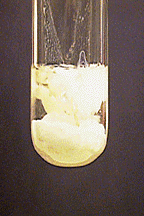
Aqueous ammonia reacts with \(\ce{Hg2Cl2}\) to produce metallic mercury (black) and mercury(II) amidochloride (white), a disproportionation reaction:
\[\ce{Hg2Cl2(s) + 2NH3(aq) -> Hg(l) + HgNH2Cl(s) + NH4^{+}(aq) + Cl^{-}(aq)} \nonumber \]
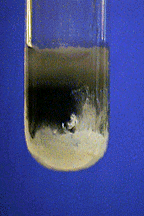
Aqueous Ammonia
Aqueous ammonia produces a mixture of a white basic amido salt and metallic mercury:
\[\ce{2Hg_2^{2+}(aq) + 4NH3(aq) + NO3^{-}(aq) + H2O(l) -> 2Hg(l) + Hg2ONH2NO3(s) + 3NH4^{+}(aq)} \nonumber \]
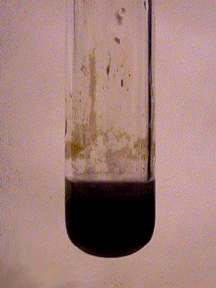
The precipitate is not soluble in excess aqueous ammonia.
Sodium Hydroxide
Black finely divided mercury metal and yellow mercury(II) oxide (\(\ce{HgO}\)) are precipitated by \(\ce{NaOH}\):
\[\ce{Hg_2^{2+}(aq) + 2OH^{-}(aq) -> Hg(l) + HgO(aq) + H2O(l)} \nonumber \]

Reducing Agents
Reducing agents, such as \(\ce{Sn^{2+}}\) and \(\ce{Fe^{2+}}\), reduce mercury(I) to the metal:
\[\ce{Hg_2^{2+}(aq) + 2Fe^{2+}(aq) -> 2Hg(l) + 2Fe^{3+}(aq) } \nonumber \]
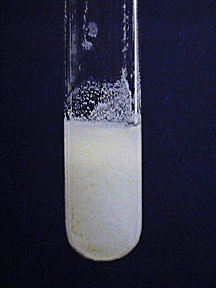
Consult an activity series or a table of reduction potentials for other possible reducing agents.
No Reaction
\(\ce{SO4^{2-}}\) (unless solutions are concentrated; solubility of mercury(I) sulfate is 0.06 g per 100 mL of water at 25oC)
Mercury(II) Ion: Hg²⁺
Characteristic reactions of \(\ce{Hg^{2+}}\)
Chloride Ion
No reaction is visible, but Hg(II) will be present as \(\ce{[HgCl4]^{2-}}\).
Aqueous Ammonia
Aqueous ammonia produces white amido salts whose composition depends on the mercury(II) salt present in the solution:
\[\ce{HgCl2(aq) + 2NH3(aq) <=> HgNH2Cl(s) + 2NH4^{+}(aq) + Cl^{-}(aq)} \nonumber \]
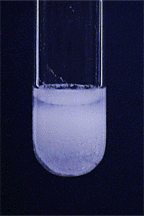
These salts are not soluble in excess aqueous ammonia, but do dissolve in acids:
\[\ce{HgNH2Cl(s) + 2H^{+}(aq) + Cl^{-}(aq) <=> HgCl2(aq) + NH4^{+}(aq) } \nonumber \]
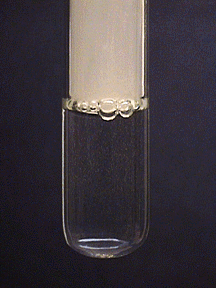
Sodium Hydroxide
A yellow precipitate of \(\ce{HgO}\) is produced by \(\ce{NaOH}\):
\[\ce{Hg^{2+}(aq) + 2OH^{-}(aq) -> HgO(s) + H2O(l)} \nonumber \]
\[\ce{HgCl2(s) + 2OH^{-}(aq) -> HgO(s) + H2O(l) + 2Cl^{-}(aq)} \nonumber \]
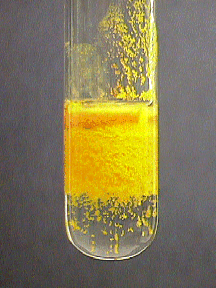
The mercury(II) oxide precipitate is insoluble in excess hydroxide but is soluble in acids:
\[\ce{HgO(s) + 2H^{+}(aq) <=> Hg^{2+}(aq) + H2O(l)} \nonumber \]
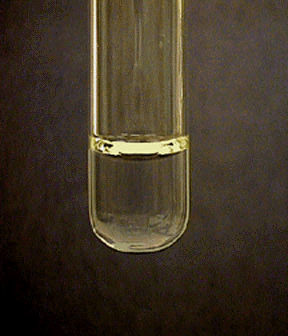
Hydrogen Sulfide
Hydrogen sulfide precipitates black mercury(II) sulfide, the least soluble of all sulfide salts.
\[\ce{Hg^{2+}(aq) + H2S(aq) <=> HgS(s) + 2H^{+}(aq)} \nonumber \]
\[\ce{[HgCl4]^{2-}(aq) + H2S(aq) <=> HgS(s) + 2H^{+}(aq) + 4Cl^{-}(aq)} \nonumber \]

Mercury(II) sulfide is insoluble in 6 M \(\ce{HNO3}\) or 12 M \(\ce{HCl}\), even if heated. However, it is soluble in aqua regia (3:1 HCl:HNO3) and in hot dilute \(\ce{NaOH}\) containing excess sulfide.
\[\ce{3HgS(s) + 12Cl^{-}(aq) + 2NO3^{-}(aq) + 8H^{+}(aq) -> 3[HgCl4]^{2-}(aq) + 2NO(g) + 3S(s) + 4H2O(l)} \nonumber \]
\[\ce{HgS(s) + S2^{-}(aq) <=> [HgS2]^{2-}(aq)} \nonumber \]
Tin(II) Chloride
Tin(II) chloride reduces \(\ce{Hg(II)}\) to \(\ce{Hg(I)}\) or to metallic \(\ce{Hg}\), giving a white or gray precipitate:
\[\ce{2[HgCl4]^{2-}(aq) + [SnCl4]^{2-}(aq) <=> Hg2Cl2(s) + [SnCl6]^{2-}(aq) + 4Cl^{-}(aq)} \nonumber \]

No Reaction
\(\ce{SO4^{2-}}\) (may precipitate as a mixed sulfate-oxide - a basic sulfate - \(\ce{HgSO4 \cdot 2HgO}\))


